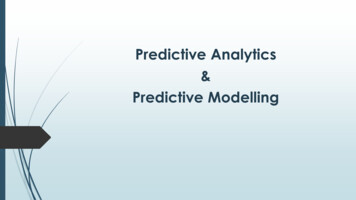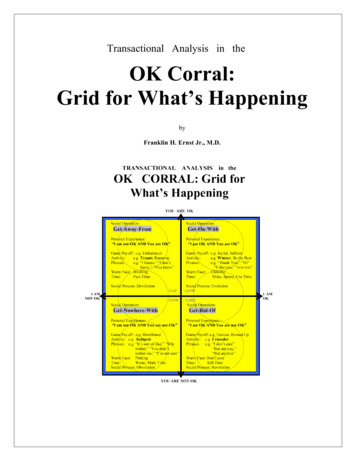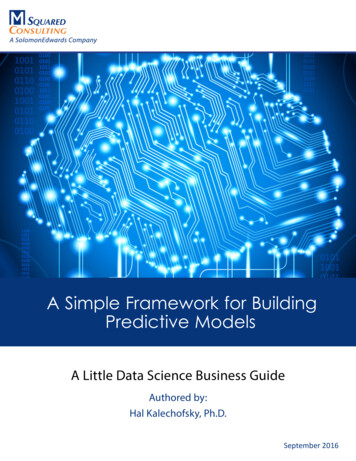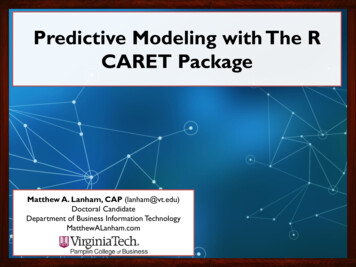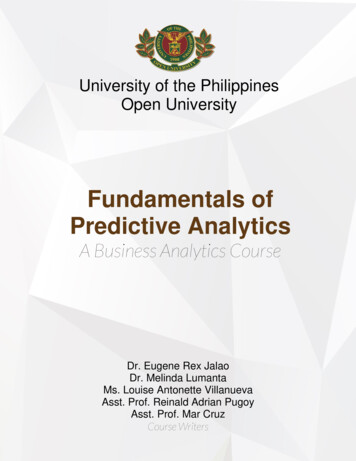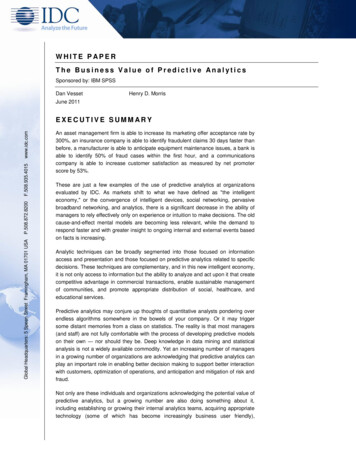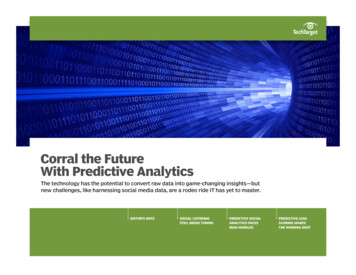
Transcription
Corral the FutureWith Predictive AnalyticsThe technology has the potential to convert raw data into game-changing insights—butnew challenges, like harnessing social media data, are a rodeo ride IT has yet to master.Editor’s noteSocial ListeningStill Needs TuningPredictive SocialAnalytics FacesHigh HurdlesPredictive LeadScoring Makesthe Winning Shot
editor’snoteHomeEditor’s NoteSocial ListeningStill Needs TuningPredictive SocialAnalytics FacesHigh HurdlesPredictiveLead ScoringMakes theWinning Shot2Targeting Fresh InsightsWhile predictive analytics is no crystalball, businesses are increasingly turning to it toanticipate trends and consumer behavior.The concept is not new; financial institutionshave long used a form of it when reviewingloans. But the rise of machine learning and bigdata are unlocking new tactical and strategicpossibilities—seemingly disparate data pointscan be connected to form clear calls to actionfor savvy users.But hurdles remain. The technology is stillmaturing, and business processes will likelyneed to evolve as data-driven analysis takes alarger role in decision making.A timely example of these issues is predictive analytics for social media. Businessesare collecting unprecedented consumer datathrough social media sites, and there’s growinginterest in the prospect of using that information strategically to get a jump on opportunities or potential issues. But even the largestCorral the Future With Predictive Analyticscompanies face technological and organizational challenges, as the first article in thishandbook, on Wal-Mart’s analytics program,shows.Reliable data is crucial for predictive analytics efforts. But it’s hard to match the sentiments expressed on social media to specificcustomers. The second article explores howthe separation of consumer profiles and socialmedia handles is proving problematic.Predictive analytics can also help businessesincrease efficiency, as outlined in the third article. Through a combination of consumer analysis and evaluating where a given company hashad past success, the technology helps businesses focus finite resources on the mostpromising leads. But human analysis remains akey cog in the process. nNathan LambSite Editor, SearchContentManagement
managementSocial Listening Still Needs TuningHomeEditor’s NoteSocial ListeningStill Needs TuningPredictive SocialAnalytics FacesHigh HurdlesPredictiveLead ScoringMakes theWinning Shot3Chandler Wilson is familiar with the challenges of translating Web chatter into actionable predictive insights. He’s director of insightand analytics at Wal-Mart Stores Inc., theBentonville, Ark., national retailer, which usesBrandwatch social media listening and analytics as part of its corporate strategy team. A firmbeliever that analytics can provide valuableinsight by drawing correlations that humansmiss, Wilson would like to be able to use automated predictive analytics tools that couldcontinuously comb relevant conversations onsocial media platforms and then pass alongrecommendations as situations arise. But thetechnology is still catching up to his desire, andmuch of that process remains manual.“From an information-to-action standpoint, I still have to look at Brandwatch anddo a report and that takes a long time,”he said. “Reporting and dissemination aretime-consuming.”Corral the Future With Predictive AnalyticsMost enterprises deploy social media listening to keep abreast of pertinent Web discussions. Applied correctly, intelligence fromsocial media monitoring reduces response timeduring a crisis and helps businesses get aheadof emerging issues.Predictive analytics can potentially take thatprocess further by creating a formula in whichsocial conversation, contextual data and thegauging of current trends to predict futureevents can help a company capitalize on a coming trend or avoid an imminent problem.But tool immaturity remains a major obstacle, said Real Story Group analyst KashyapKompella. Given the sheer volume of Web traffic and social conversation, predictive socialanalytics requires some degree of automation,which in turn requires developing algorithmsthat can reliably interpret sentiment and helpdraw correlations between key data points.Sentiment analysis tools are being piloted to
managementHomeEditor’s NoteSocial ListeningStill Needs TuningPredictive Socialhelp make those connections, but Kompellasaid that technology is accurate only 50% to70% of the time.“If you are going to make big changes basedon sentiment, you would want the accuracy tobe higher than it currently is,” he said. “Most ofthe tools demo well because they’re using veryclean data sets, but when you meet messy, realworld data—which is complex, multilingualand with all sorts of new patterns that keepcoming up—that breaks down.”Analytics FacesHigh HurdlesPredictiveLead ScoringMakes theWinning Shot4Silos Need BridgesKompella listed context as another key issue.Social media profiles are typically not connected to consumer profiles that reside in customer relationship management systems, andthat makes it difficult to gauge key metrics,such as a consumer’s intent to buy.“If a 14-year-old says he’s going to buy a Ferrari, there’s purchase intent, but it’s probably30 years down the road, versus an executivesaying they’re going to buy a Ferrari when theyget a bonus,” he said. “They both voiced intent,but from a marketing or actionable perspective,Corral the Future With Predictive Analyticsyou really need to know something beyondwhat is being said in the conversation itself.”“The current challenge is that there’s thesocial silo and there’s the enterprise silo,” hecontinued. “The real ROI is when you’re ableto merge these things; it’s a problem [that] hasnot effectively been solved yet.”“ If a 14-year-old says he’s goingto buy a Ferrari it’s probably30 years down the road, versusan executive saying they’regoing to buy a Ferrari.”—Kashyap Kompella, analyst,Real Story GroupIt’s not just an external issue. If softwarevendors can get predictive algorithms up tospeed and break down data silos, Gartner analyst Jenny Sussin said companies need to facethe internal challenge of mapping out organizational responses to the data they receive.“A lot of it is process stuff when it comesto actionable insights,” she said. “Even if youhave a predictive algorithm, if you don’t have
managementHomeEditor’s NoteSocial ListeningStill Needs TuningPredictive SocialAnalytics FacesHigh HurdlesPredictiveanybody who can actually take action on theinsight, it doesn’t really mean anything.”Wilson expected Wal-Mart will continueto invest in predictive analytics tools, sayingthey plan on applying data-driven insights toevery department, from supply chain to product sales, in the near future. But he anticipatedthat would likely require updating the company’s decision architecture.“We have started to move in the direction ofbeing more aligned strategically,” he said. “Wehave to monitor our internal information flowas much as the external, because otherwise wecan’t leverage the information.”Lead ScoringMakes theWinning ShotMoving Toward PredictiveDespite the obstacles, Kompella said businesses are increasingly investing in socialanalytics with the immediate goal of showingclearer ROI for social media outlay. He citedrecent results from market researcher TheCMO Survey in which respondents reportedthat social media on average consumes 9.9%of marketing budgets—with that number projected to hit 22% in the next five years.5Corral the Future With Predictive AnalyticsBut analytics is only a small fraction of thatbudget—about 1% to 2%, Kompella said. Companies still have a ways to go to incorporateanalytics into business decisions.Analytics should do morethan reinforce known insights.Predictive data should alsochallenge executives to see thebusiness environment in newways and make decisions basedon the data.“Most of the current analytics are gearedtoward vanity metrics, such as [number of]people engaged, rather than how many leadsyou actually generated,” he said. “The way youdemonstrate ROI is through better use of analytics, and that requires maturity of the toolsthemselves, as well as the capacity of the companies to exploit these tools better.”UrbanBound LLC is a Chicago-based company that produces software to help humanresources departments manage employee relocation. The company uses HubSpot technology
managementHomeEditor’s NoteSocial ListeningStill Needs TuningPredictive SocialAnalytics FacesHigh Hurdlesto handle social media listening and analytics,primarily for customer interaction and marketing efforts, said UrbanBound vice president ofmarketing Erin Wasson.Wasson said the tools are used primarily toevaluate which posts are creating the most newbusiness. Content marketing is UrbanBound’sprimary source of leads with social generating roughly 15%—but she expected that to risesoon when the company hires a social mediaspecialist.“I definitely see social media growing, andwe’re going to invest in the opportunitiesPredictiveLead ScoringMakes theWinning Shot6Corral the Future With Predictive Analyticsthere,” Wasson said.In general, Kompella suggested it’s a goodidea to focus on the added value when considering analytics. Analytics should flesh outa picture and do more than reinforce knowninsights. Predictive data should also challengeexecutives to see the business environment innew ways and make different, even unorthodox,decisions based on the data.“Are these analytics really helping you validate what you already know?” Kompella asked.“Or are they telling you something you hadn’tthought of?” —Nathan Lamb
ImplementationPredictive Social Analytics Faces High HurdlesHomeEditor’s NoteSocial ListeningStill Needs TuningPredictive SocialAnalytics FacesHigh HurdlesPredictiveLead ScoringMakes theWinning Shot7Social media listening platforms alloworganizations to follow Web discussions, andthere’s growing interest in the idea that analytics could convert knowledge into actionableinsights about the future.Social media listening looks at what people are talking about on sites like Facebook,Twitter and LinkedIn as well as in blog posts,reviews and comment sections on the Internet. It’s a vast data set, but analytics offers theprospect of distilling relevant conversationsinto discernable signals that will help businesses proactively meet consumer needs.Using analytics to anticipate the future isn’tnew, according to Olivia Parr-Rud of the OliviaGroup, a consultancy specializing in predictive analytics. Over the past 20 years, banks,credit card and insurance companies have usedthat type of information to evaluate customers’credit risk.The difference with predictive analytics forCorral the Future With Predictive Analyticssocial media is the immediacy of the information. “It really shows what the person is interested in right now,” Parr-Rud said. Businessesthat have that information can make real-timeoffers, knowing that the offer is relevant to acustomer’s current interest and therefore morelikely to be acted on.Still, using insights from today to predictthe future is easier said than done. Companiesoften struggle with whether the insights theyhave gathered are truly predictors of the future.They also struggle with how to translate thoseinsights into an action plan. And, of course,many companies have siloed departments anddata that make aggregating data and creating aunified strategy an obstacle.Not Helpful Enough—YetDespite the existence of social listening tools,most companies struggle to anticipate what
ImplementationHomeEditor’s NoteSocial ListeningStill Needs TuningPredictive SocialAnalytics Facestheir most valued customers will do next, saidAllison Smith, an analyst at Forrester Research.Smith said it could be years before thatchanges. In the meantime, customer insightprofessionals are under pressure to show ROIfor the high cost of data mining.Businesses often ask customersfor their email addresses, butthey perhaps should begin askingfor their Twitter han dles.High HurdlesPredictiveLead ScoringMakes theWinning Shot8The problem is finding the right sources ofdata and then tying that information correctlyto a customer, Smith said. Social listening platforms scour the media, searching for mentions,keywords and sentiments. Of the three typesof media—owned (a business website or company-owned Facebook page), paid (social ads orbanners) and earned (reader reviews, customerblogs)—earned media is hardest to find andtrack.Once that information is found, businessescan exploit it when they know who said it andwhy. For example, it would be useful to know ifCorral the Future With Predictive Analyticsthe person who posted negatively about yourproduct was a longtime customer or not.Connecting that sentiment to a specific customer through a company’s customer relationship management (CRM) system would addcontext to the comment, but Smith said manyCRMs are not integrated with social listeningplatforms.“The piece that is missing is the data layerwith the customer. [Is] this Allison Smithon Twitter the same Allison who is our customer?” Smith explained. Businesses often askcustomers for their email addresses, but theyperhaps should begin asking for Twitter handles and other social media identification.“A lot of customers may struggle with [giving up some privacy], but the brand can thenprovide more targeted offers and more relevantadvertising,” Smith said. If customers understand that they get something in return, theymay be more likely to divulge information.Businesses Making HeadwayOrganizations continue to look for ways toidentify their target markets and send directed
ImplementationHomeEditor’s NoteSocial ListeningStill Needs TuningPredictive SocialAnalytics FacesHigh HurdlesPredictivemessages to them, eventually hoping to drilldown to specific customers.Pulsar, a social intelligence platform, usesaggregated data from Facebook to help its clients understand what people from certaindemographics are talking about. The FoodExperts advise companiesthat use predictive social mediaanalytics to know what they’relooking for, how they’ll use thedata to relate to customers andhow to measure their efforts.“Through the profiling of target audiences,we were able to get messages out to the rightdemographics, via their trusted influencers, and across the channels that they use,”explained James Baker, social media managerfor the agency.As businesses look to use predictive socialmedia analytics, Smith and Parr-Rud offeredthe following recommendations: Lead ScoringMakes theWinning Shot9Standards Agency, a government agency inthe U.K., used Pulsar when it wanted to getthe word out about the dangers of DNP, a fatburning supplement popular among teenagers. Through social media listening, the agencyidentified where those key terms were used onsocial media, which indicated where the useractivity was. The Food Standards Agency thentargeted those areas with educational messages and used influencers to spread the wordin social media hot spots.Corral the Future With Predictive Analytics Know what you’re looking for, and ask theright questions to get the answers you want.In a Forrester brief on predictive social analytics, Smith said that when an online ticketevents company searched the name of theartist Beyoncé, that name alone didn’t correlate with buying concert tickets. Searchingfor more specific sentiments, such as favorable comments about Beyoncé’s concerts,provides more accurate information.Know how you’ll use the data to relate to thecustomer. Do you have a plan to use it as partof your marketing or business goals? Howwill you use the information to be forwardthinking and not just backward-looking?
Implementation HomeEditor’s NoteSocial ListeningDetermine from the beginning how to measure efforts. Many companies consider this amidstream concern, but they should plan thisfrom the start and choose key performanceindicators that outline the results they hopeto gain. But keep in mind that some resultsare not direct. For example, increased websiteactivity by a customer does not always translate to an immediate purchase.Still Needs Tuning Predictive SocialAnalytics FacesHigh HurdlesPredictiveKnow if you can integrate data from sociallistening or intelligence with your CRM data,which would give you a customized view ofyour target customers.Lead ScoringMakes theWinning Shot10Corral the Future With Predictive AnalyticsMost organizations are still maturing in theiruse of predictive social analytics, Smith said.These companies may understand how to monitor and listen to data on social media. Moreadvanced businesses are the ones using theanalysis for business intelligence. The mostmature businesses integrate social media predictive analytics with other sources of information, such as CRM, to provide social andnonsocial feedback.Although it may take some time to get tothat last level of maturity, the companies thatdo will have a distinct advantage.—Pamela DeLoatch
methodsPredictive Lead Scoring Makes the Winning ShotHomeEditor’s NoteSocial ListeningStill Needs TuningPredictive SocialAnalytics FacesHigh HurdlesPredictiveLead ScoringMakes theWinning Shot11For many companies, today’s marketingand sales funnel is a confusing mess. The topof the funnel is swelling with increasingly moreleads that are responding to an avalanche ofcontent marketing and “freemium” or try-tobuy offers. But the bottom of the funnel canseem like it’s moving at a trickle as salespeoplestruggle to identify the most promising leads,fueling lower sales rates, lower average sellingprices and longer cycles to close deals.The funnel encompasses both marketing andsales processes, from a company’s initial contact with a prospective customer to the finalsale. Marketers are responsible for the top,working to gather contact information andbasic qualification data for new sales prospects.As it narrows toward the bottom, the funnel represents sales prospects that are furtheralong in the buyer’s journey. The funnel canbecome a flashpoint between sales and marketers when marketers provide poor-quality leadsCorral the Future With Predictive Analyticsand expect sales to close deals nonetheless.When sales fails to follow up on good prospects in a timely manner, it leaves the marketer’s work fallow and wasted.For many companies, marketing automationplatforms’ rules-based lead scoring does notgo far enough to fix the problems with the funnel. Last year, SiriusDecisions found that 68%of companies used marketing platforms to dolead scoring—but only 40% of salespeoplebelieved that it was effective. That’s why companies are turning to predictive lead scoring,which harnesses the power of big data to identify the leads that are most likely to convert,close and generate the maximum revenue forthe company.The Hard NumbersPredictive lead scoring can provide a “credible,third-party source of truth between sales and
methodsHomeEditor’s NoteSocial ListeningStill Needs TuningPredictive SocialAnalytics FacesHigh HurdlesPredictiveLead ScoringMakes theWinning Shotmarketing,” said Melissa Davies, head of globalmarketing operations at SLI Systems, whichuses Lattice Engines, a predictive lead-scoringtechnology. When salespeople focus on the topleads, sales can grow. Software vendor Infer hashelped ZipRecruiter salespeople to spend 90%of their time getting high-quality leads compared with just 72% in the past.By focusing on the right leads, DocuSign,which also uses Lattice Engines, experienceda 38% increase in the predictability of conversions, according to Ryan Schwartz, formerdirector of marketing systems and operationsat DocuSign. Lattice Engines’ chief marketingofficer, Brian Kardon, said that predictive leadscoring can shorten sales cycles from 180 daysto as few as 100 days and can increase the average deal size by 20%. Finally, continuous success metrics and automated models make iteasier for companies to refine and update leadscoring to increase accuracy over time. So howdoes predictive lead scoring work?Start With a ModelThe first step is to develop a predictive modelbased on a company’s particular needs. Thegood news is that you don’t need to hire an inhouse data science team to create the model.In a few weeks, cloud-based predictive leadscoring vendors can provide a learning databaseto create an automated lead-scoring model.The database incorporates the customer’s leaddata, won data and other data from enterprise resource planning, marketing, CRM andcustomer service systems as well as externalinformation.The vendor’s software then creates an automated model that identifies the best positiveand negative success predictors from thousands of potential internal and external signals and attributes. Some customers will holdback a portion of their data for back testingin order to assess the model’s accuracy. Typically, you need 100 successful outcomes to create a reliable model, but the vendor can providePredictive lead scoring uses big data to iden tify the leads that are mostlikely to convert, close and generate maximum revenue for a company.12Corral the Future With Predictive Analytics
methodsguidance based on its experience and yourneeds. Predictive lead scoring probably won’thelp you if you’re a new company with fewsuccessful outcomes or wins.HomeEditor’s NoteSocial ListeningStill Needs TuningThe whole idea of predictivelead scoring is to identify thefactors that drive positive results.But it also requires humans tocorrectly interpret the data.Predictive SocialAnalytics FacesHigh HurdlesPredictiveLead ScoringMakes theWinning Shot13The vendor’s analytical engine then usesmachine learning to identify the top successpredictors and creates a predictive scoringalgorithm based on the relative weight of eachattribute. The result is a straightforward leadscore that might range from one to 10, indicating a low-to-high likelihood to buy, lifetimevalue, stage of the buyer’s journey or a combination of all three. Some vendors also providea rationale for each score.As new leads and new data come in, predictive models send lead scores to your marketing and CRM systems using prebuilt APIs. “Theideal lead-scoring system should show the whyCorral the Future With Predictive Analyticsversus a black-box approach,” said AlisonMurdock, vice president of marketing at6sense. “The why tells sales reps what buyeractivity led to the score so the rep can use theintelligence to drive a better-informed salesprocess.”Lighting Up the Black BoxThe software can lack transparency about someof its assumptions in lead scoring and otheranalysis. These technologies use algorithmsthat can be difficult to work with. Many companies want greater transparency—or controlof—how these algorithms are set and what thecriteria and priorities are.The black-box nature of these models creates another challenge: They may not be intuitive to, or believed by, stakeholders. The wholeidea of predictive lead scoring is to identifythe factors—some expected, some not—thatdrive positive results. But just like any insight,predictive lead scoring requires humans tocorrectly interpret the data (that is, to makesure that the model is accurate). And thatmeans bringing in not only marketers but also
methodssales leaders and potentially even independent data scientists who can assess the model’svalidity.Always ImprovingHomeEditor’s NoteSocial ListeningStill Needs TuningPredictive SocialAnalytics FacesHigh HurdlesPredictiveLead ScoringMakes theWinning Shot14Expect to develop the model iteratively toimprove accuracy—both before and after golive. Using an iterative approach to modeldevelopment, DocuSign’s Schwartz emphasized, puts the focus on the accuracy of thescore. Although the lead scores should be reliable, they may also be counterintuitive to salesrepresentatives. So you may want to keep thelower-scoring leads in marketing for nurturing,passing only the high-scoring leads to sales sothey can focus on closing deals with the rightCorral the Future With Predictive Analyticsleads. “Developing accurate scoring is important, but what’s necessary for achieving success is the application of the score,” said VikSingh, CEO of Infer. “A score itself is neitheractionable nor sticky: It’s what you do with itthat counts.”Predictive lead-scoring systems also includereporting that enables marketing and salesleaders to track the effectiveness of the models, so they can be modified as needed. As youadd more data, the model can become smarterand may be updated on different time frames,depending on your needs.Knowledge helps salespeople prioritize better, sell and close business. Predictive leadscoring can deliver the intelligence they needto do just that. —Steve Robins
abouttheauthorsPamela DeLoatch covers business-to-business andtechnology issues. She has written articles, profiles andcase studies for numerous organizations. Email her atpamela@b2bstorytelling.com.Nathan Lamb isHomeEditor’s NoteSocial ListeningStill Needs Tuningthe site editor for SearchContentManagement. He covers enterprise collaboration,content management and information governance.He previously worked as a newspaper reporter andeditor, most recently with Gatehouse Media NewEngland. Email him at nlamb@techtarget.com.Predictive SocialAnalytics FacesHigh HurdlesPredictiveLead ScoringMakes theWinning ShotSteve Robins isa consultant at Solution MarketingStrategies, a consultancy that advises companies onmarketing and demand generation strategies, segmentation and messaging. Robins has held senior marketing roles at FirstBest Systems, EMC, Documentum andKANA Software. Email him at steven@solutionmkt.com.Corral the Future With Predictive Analytics is aSearchContentManagement.com e-publication.Jason Sparapani Managing EditorMoriah Sargent Associate Managing EditorLauren Horwitz Executive EditorNathan Lamb Site EditorMartha Moore Production EditorLinda Koury Director of Online DesignNeva Maniscalco Graphic DesignerDoug Olender Publisherdolender@techtarget.comAnnie Matthews Director of Salesamatthews@techtarget.comTechTarget275 Grove Street, Newton, MA 02466www.techtarget.com 2015 TechTarget Inc. No part of this publication may be transmitted or reproduced in any form or by any means without written permission from thepublisher. TechTarget reprints are available through The YGS Group.Stay Connected!Follow @sContentMgmt today.15Corral the Future With Predictive AnalyticsAbout TechTarget: TechTarget publishes media for information technologyprofessionals. More than 100 focused websites enable quick access to a deepstore of news, advice and analysis about the technologies, products and processes crucial to your job. Our live and virtual events give you direct access toindependent expert commentary and advice. At IT Knowledge Exchange, oursocial community, you can get advice and share solutions with peers and experts.cover art: iStock
PrEdictivE social analytics FacEs HigH HurdlEs PrEdictivE lEad scoring MakEs tHE Winning sHot corral the Future With Predictive analytics The technology has the potential to convert raw data into game-changing insights—but new challenges, like harnessing social media data, are a rodeo ride IT has yet to master.


